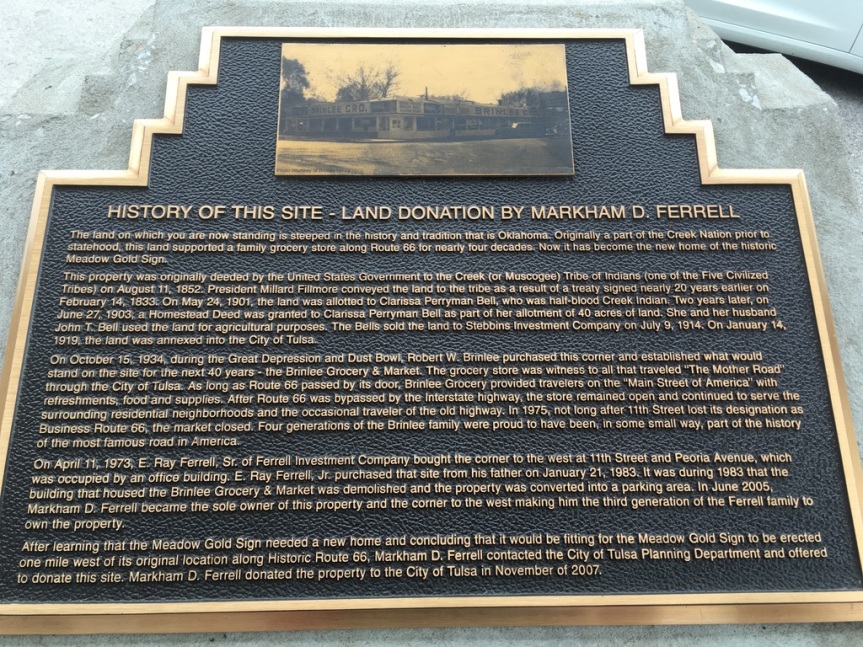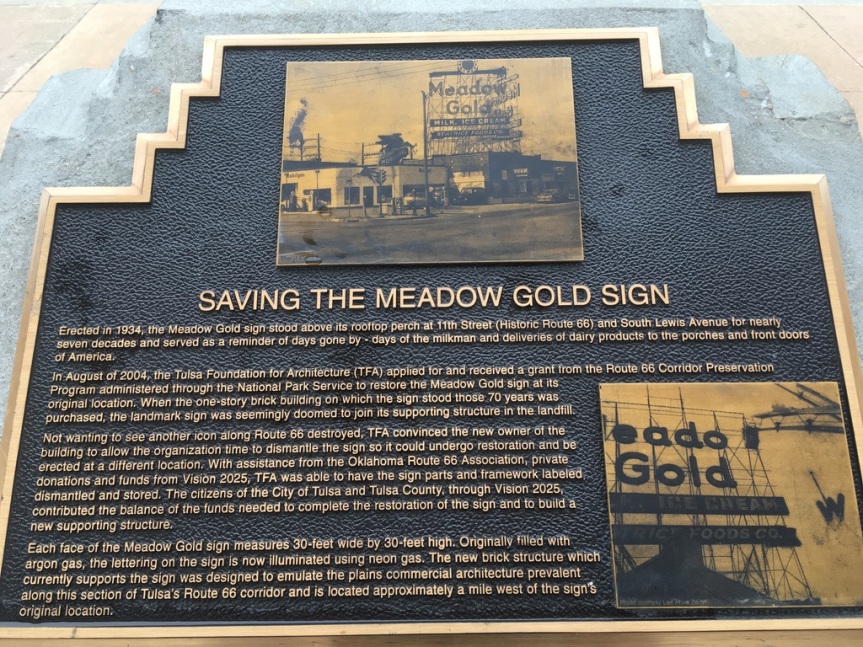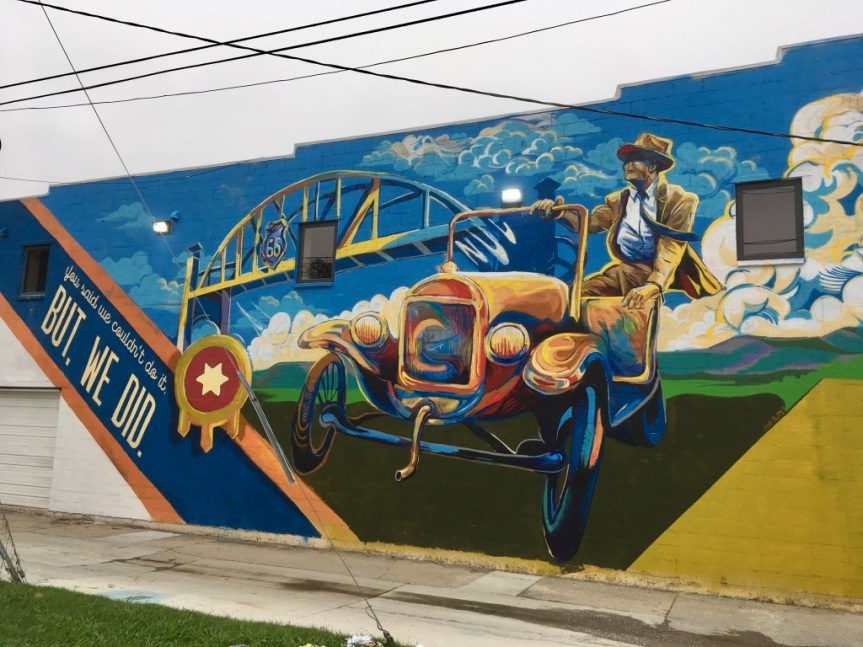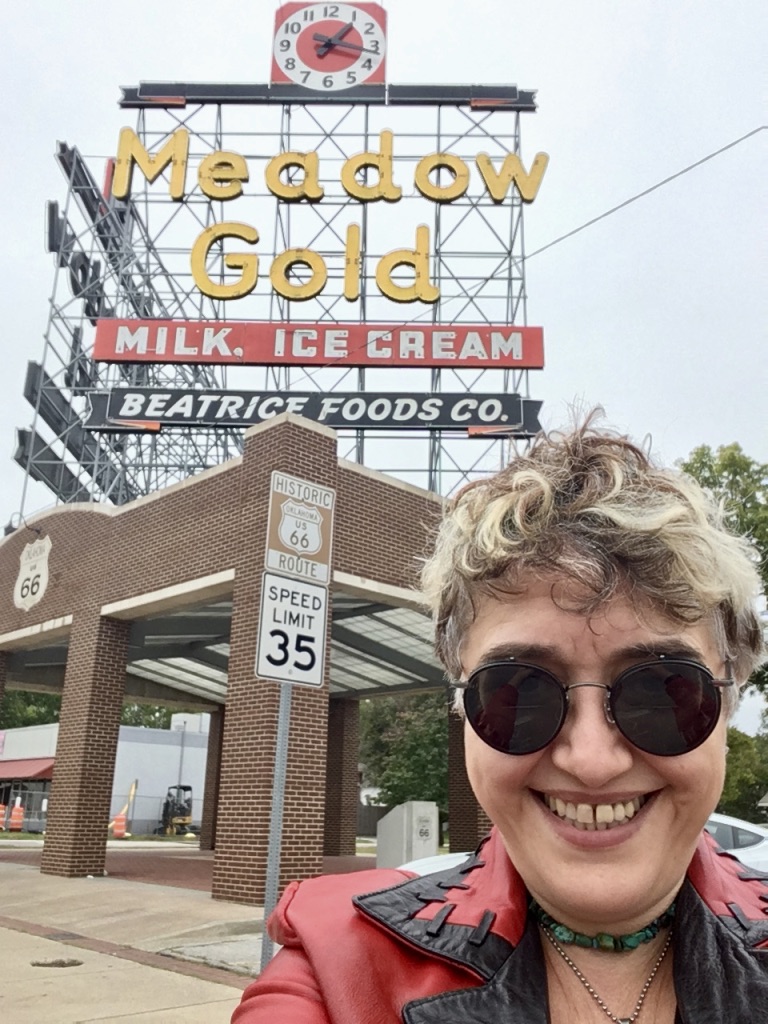If you drive down Route 66 in downtown Tulsa Oklahoma you can’t but see the Meadow Gold Sign. All of the “what to see” sources had talked about this sign as an iconic Route 66, and when I first saw it I had assumed (never assume) that they had destroyed the original building but they kept the sign — and thought that there was something glorious about that… but I was wrong. While the sign had always been on historic Route 66, its original location had been at about a mile East (but still on the route) at the corner of 11th Street and Lewis Avenue.

The sign is in fact a set of two signs that once stood back to back (note the back of the 2nd in the picture above), but is now set at a sort of V alignment. This was done to serve its new purpose, as historical art, that has been made easily visible to traffic moving in either direction on route 66.
 Originally installed in the 1930’s, on top of a small one story building, the sign’s lights started going dark in the 1970’s. Once the building where it had sat was destroyed (now an “Advanced Auto Parts” store) this iconic to the city neon-sign was saved from the wrecking ball, and began to be restored in 2004 (to the tune of $337K), and moved to this new location on Route 66, which was donated to the city for this purpose. What it stands upon is more of a shelter from the elements, than a building, and has a collection of brass plates explaining bits of the history of the sign.
Originally installed in the 1930’s, on top of a small one story building, the sign’s lights started going dark in the 1970’s. Once the building where it had sat was destroyed (now an “Advanced Auto Parts” store) this iconic to the city neon-sign was saved from the wrecking ball, and began to be restored in 2004 (to the tune of $337K), and moved to this new location on Route 66, which was donated to the city for this purpose. What it stands upon is more of a shelter from the elements, than a building, and has a collection of brass plates explaining bits of the history of the sign.
 The restoration and moving of the sign was a project that involved many hands. Initially the Tulsa Foundation for Architecture (TFA) had received a small grant of $15K from the National Park Service‘s (NPS), Route 66 Corridor group to restore the neon sign. This was done through their “National Center for the preservation of Technology” group, among whose stated goals is the preservation of the neon signs along Route 66. This is being undertaken in recognition that neon signs are not JUST advertising, they are a form of functional-art; and that together, these signs help to evoke earlier times along Route 66, but that are just like our historic buildings are currently under threat by neglect or demolition and can only be saved from the shortsightedness of the market place by government intervention. Maintaining these past technological structures is important not only historically, but also because it supports local economies through tourism.
The restoration and moving of the sign was a project that involved many hands. Initially the Tulsa Foundation for Architecture (TFA) had received a small grant of $15K from the National Park Service‘s (NPS), Route 66 Corridor group to restore the neon sign. This was done through their “National Center for the preservation of Technology” group, among whose stated goals is the preservation of the neon signs along Route 66. This is being undertaken in recognition that neon signs are not JUST advertising, they are a form of functional-art; and that together, these signs help to evoke earlier times along Route 66, but that are just like our historic buildings are currently under threat by neglect or demolition and can only be saved from the shortsightedness of the market place by government intervention. Maintaining these past technological structures is important not only historically, but also because it supports local economies through tourism.

Once the initial seed funding ($15K) had been secured by the TFA from the NPS, this “primed the pump” so to speak, making it easier to raise matching funds from other sources — to the tune of $322,273, the actual cost of restoration. Among these were the privately funded National Trust for Historic Preservation, the Oklahoma Route 66 Association. And then more funds were collected from the public at large via the City’s Vision 2025 initiative; this was a new one cent tax increase that would be maintained for 13 years whose proceeds were earmarked towards economic development and capital improvement projects, such as saving the Meadow Gold sign — but that had to be agreed to by the voters of Tulsa County.

This tax was ultimately instituted, in part as a result of multiple newspaper articles about how the sign was in danger of being destroyed, and that funding was desperately being at first being sought, and this new tax was needed to that end.

Meadow Gold had been a dairy brand that belonged to the Beatrice Foods Company, founded in 1894 initially as the Beatrice Creamery Company, and then incorporated in 1905 as the Beatrice Creamery Company of Iowa. During that time they had begun the Meadow Gold dairy brand — which by World War II was a household name in much of America, and had branched out into the development of other dairy products … so that in 1946 the company changed its name yet again to simply the Beatrice Foods Co., as visible on the sign.

That said, the in the 1980’s the Beatrice fell on hard times mostly of their own construction. They lost a major lawsuit against them for toxic dumping (which resulted in an award-winning book and a film called A Civil Action), and they operated in South Africa during apartheid and hence suffered from some boycotting. As the company had taken on many other non-food business over the years, in 1984 they changed their name from Beatrice Foods Co. to Beatrice Companies, Inc., and then sold off their Meadow Gold Brand, along which was now part of their Beatrice Dairy Products, Inc., subsidiary, along with a couple of other brands, to Borden, Inc. in December 1986 for $315,000,000. Borden then went defunct in 2001, so that the Meadow Gold brand (which is still an American household name) is now owned by Dean Foods.

Interestingly, I did not find a SINGLE source talking about how the Meadow Gold brand or Dean foods chipped in to help save the sign advertising THEIR product. BUT, I could of course be wrong, and maybe they did so anonymously — which from a political standpoint would make sense.


What a great write up! Thanks for stopping in Tulsa. Here’s a bit more about that phrase on the mural:
LikeLiked by 1 person
What a wonderful write up! Thanks for stopping in Tulsa. Here’s a little more about the phrase on the mural:
https://rhysfunk.com/2018/07/02/you-said-we-couldnt-do-it-but-we-did/
LikeLiked by 1 person
GREAT!!! Thanks!
LikeLike
Rhysfunk, you MIGHT want to read the writeup I just finished on the Milk Bottle building, since you seem to have gone there.
LikeLike
I have been searching meadow gold ice cream. I have recovered an antique sign. All I have found out about the sign is that they produced the first hokey pokey ice cream. In New Zealand.
The label was brought by Vestey Brothers (UK) in the 1960s. Vestey family was 2nd wealtist behind the Winsors (Royal Family) in the UK at that time. I am going to sell the sign is my intention. Michael Heerdegen.
LikeLike